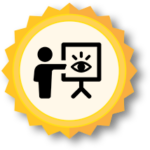Active Learning Strategy: Minute Papers
 Overview and Introduction: The WHAT and WHO
Overview and Introduction: The WHAT and WHO
 The One-Minute Paper is a classroom assessment technique and active learning strategy that is used to collect student feedback and assess student learning about a topic. At the end of class, students respond in brief to one or two questions. Plan to allow students at least ten minutes at the end of class to respond and adjust time parameters based on student needs. Questions can be tailored based on the type of information one wishes to collect [1].
The One-Minute Paper is a classroom assessment technique and active learning strategy that is used to collect student feedback and assess student learning about a topic. At the end of class, students respond in brief to one or two questions. Plan to allow students at least ten minutes at the end of class to respond and adjust time parameters based on student needs. Questions can be tailored based on the type of information one wishes to collect [1].
Basic Questions:
- What are the two [three, four, five] most significant [central, useful, meaningful, surprising, disturbing] things you have learned during this session? [2].
- What was the most important thing you learned in class today?
- What important question remains unanswered?
Collecting Responses Related to Student Interest [4]
- Without looking at your notes, what was most memorable or stands out in your mind about today’s class?
- What was the most surprising and/or unexpected idea expressed in today’s discussion?
- Looking back at your notes, what would you say was the most stimulating idea discussed in today’s class?
- For you, what interesting questions remain unanswered about today’s topic?
Collecting Responses Related to Relevance [4]:
- In your opinion, what was the most useful idea discussed in today’s class?
- During today’s class, what idea(s) struck you as things you could or should put into practice?
- What example or illustration cited in today’s class could you relate to the most?
Collecting Responses Related to Student Attitudes/Opinions [4]:
- Would you agree or disagree with this statement: . . .? Why?
- What was the most persuasive or convincing argument (or counterargument) that you heard expressed in today’s discussion?
- Was there a position taken in today’s class that you strongly disagreed with, or found to be disturbing and unsettling?
- What idea expressed in today’s class strongly affected or influenced your personal opinions, viewpoints, or values?
Collecting Responses Related to Student Analysis of Class Concept [4]:
- What did you perceive to be the major purpose or objective of today’s class?
- What do you think was the most important point or central concept communicated during today’s presentation?
Collecting Responses Related to Students making Conceptual Connections [4]:
- What relationship did you see between today’s topic and other topics previously covered in this course?
- What was discussed in class today that seemed to connect with what you are learning or have learned in other course(s)?
Minute Papers work well across many types of courses with all types of learners. In some instances, not all content is easily assessed or dissected in such a simplistic manner such as Minute Papers. It might be difficult in the beginning to get high quality responses, but with repetition and explanation of feedback to the whole class they will gradually improve.

 Implementation and Timing: The WHEN, WHERE, and HOW
Implementation and Timing: The WHEN, WHERE, and HOW
Typically this strategy is used at the end of a class, however, some of the literature suggest using minute papers at the beginning of a class as a warm up to see what they know, or to check in with what they recall from the previous class session [1]. When Minute Papers are used at the end of class, it is recommended to set aside between two to five minutes per question so that students have an adequate amount of time to respond.
Plan ahead: Ensure questions have been pre-determined based on the course content and what information is to be collected. Initially, it may take more time to assess the student’s minute papers for reasons such as: it is a new strategy, student responses may not be as clear, student responses may induce additional questions, etc.
Use often: Use Minute Papers frequently and with purpose. Show the students the value in their responses and take time to discuss findings with the class.
Implementation Tips
Implementing one of the following ideas, may increase the quality of student responses: Allow peers to revise one another’s papers and provide feedback, provide anonymous feedback as a class to a few responses, pull examples of high, medium and low responses and talk through observations.
Class Modalities
This strategy can be used in all learning environments; remote, hybrid, online asynchronously/synchronously, or in person. The determination of how students will turn in the Minute Papers should be addressed. Some instructors may wish to have students handwrite their minute papers while others may decide to make it a graded assessment at the end of the lesson. Other suggestions include: polling technology, use of Canvas (quizzes and discussion boards), Google Forms, etc. [3]. Choose a method for class responses that work best with your course and content.
Ideas for Implementation
- Determine the area of focus. Do you wish to use it to assess or to activate prior knowledge? Using Minute Papers as an assessment means it will be used at the end of class. If they are being used to activate prior knowledge, they need to be used at the beginning of class.
- Determine what kind of data you wish to collect. This will assist you in determining the one-two questions to ask.
- Introduce Minute Papers to the class. Provide a rationale for using the technique and how it will benefit them. Consider modeling an exemplar for students to see what you expect in terms of responses. Think about introducing sentence stems in the beginning use stages of this to support students. Including the students in this will demonstrate that you care about their feedback.
- Implement Minute Papers and ensure enough time has been carved out at the end of class to allow enough time for student responses.
- Analyze the data and look for trends, misconceptions, insightful thoughts-for those who teach large courses, let the class know that you may not read every response but instead look for trends.
- Share with the class the results/findings. Reteach if the data shows a need for it.

 Rationale and Research: The WHY
Rationale and Research: The WHY
Minute Papers require little time from staff in regards to set up and implementation. They provide feedback from students that is timely [1]. This allows instructors the opportunity to immediately check the understanding of course content and make necessary adjustments quickly. Instructors may need to invest more time in the beginning to analyze student responses and determine trends; however the more effective use of this strategy will lessen the time requirements by the instructor. There is potential for students to engage in higher levels of active learning and engagement if continued use of Minute Papers occurs. Finally, Minute Papers ask for student feedback and as a result, students might feel as if their voice matters and that their opinions matter. This in turn could support building a respectful and safe classroom environment.

 Additional Resources and References
Additional Resources and References
[1] T. A. Angelo and K. P. Cross, Classroom assessment techniques A handbook for college teachers. San Francisco: Jossey-Bass, 1993.
[2] “The minute paper – office of the provost and senior vice president.” [Online]. Available: https://provost.tufts.edu/celt/files/MinutePaper.pdf. [Accessed: 20-Sep-2022].
[3] S. Bodbyl, “Active learning in remote, virtual hybrid, online, and physically distanced classrooms,” Trefny Innovative Instruction Center, 14-Jul-2022. [Online]. Available: https://trefnycenter.mines.edu/active-learning-in-remote-virtual-hybrid-online-and-physically-distanced-classrooms/. [Accessed: 20-Sep-2022].
[4] “One-minute paper: Assess student learning: On course,” College Educator Workshops & Conferences, 01-Jul-2021. [Online]. Available: https://oncourseworkshop.com/self-awareness/one-minute-paper/. [Accessed: 20-Sep-2022].